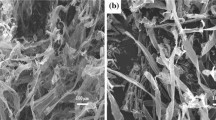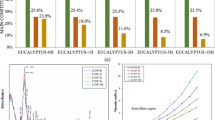Abstract
The influence of lignin content on nanocellulosic fibril morphology, charge, colloidal stability and immobilization has been systematically investigated employing a series of nanofibrillated cellulose (NFC) with varying residual lignin content and compared to those of NFC made from fully bleached pulp. The lignin-containing pulps were obtained from the fractionation of Eucalyptus globulus wood chips in gamma-valerolactone (GVL)/water under the same conditions, they differ by the intensity of washing for lignin removal. The reference pulp originated from another cook of eucalyptus wood chips, and was fully bleached with a short Elemental-Chlorine-Free (ECF) sequence. All the pulps have a comparable hemicellulose-to-cellulose ratio and CED viscosity. NFC suspensions of 1 wt% concentration were mechanically produced from fluidization. The results indicated that the fibrils morphology, thickness and corresponding flocculation within NFC suspensions was highly influenced by the presence of lignin unevenly distributed on the fibril surface and within the suspension as particles. The presence of lignin in NFC suspension had a large impact on the rheology and dewatering of the NFC. Samples with high lignin content had distinguishable viscoelastic properties due to the greater flocculation of thicker fibrils and lower gel-like characteristics, with better dewatering properties.





Similar content being viewed by others
References
Bonn D, Coussot P, Huynh HT, Bertrand F, Debrégeas G (2002) Rheology of soft glassy materials. Europhys Lett 59:786–792
Buscall R (2010) Letter to the editor: wall slip in dispersion rheometry. J Rheol 54:1177–1183. https://doi.org/10.1122/1.3495981
Chaari F, Racineux G, Poitou A, Chaouche M (2003) Rheological behavior of sewage sludge and strain-induced dewatering. Rheol Acta 42:273–279. https://doi.org/10.1007/s00397-002-0276-5
Conley K (2014) Annual review of global pulp and paper statistics. RISI Inc, PPI
Dalpke B, Kerekes RJ (2005) The influence of fibre properties on the apparent yield stress of flocculated pulp suspensions. J Pulp Paper Sci 31:39–43
Dentel SK, Abu-Orf MM, Walker CA (2000) Optimization of slurry flocculation and dewatering based on electrokinetic and rheological phenomena. Chem Eng J 80:65–72. https://doi.org/10.1016/S1383-5866(00)00078-2
Dimic-Misic K, Puisto A, Gane P, Nieminen K, Alava M, Paltakari J, Maloney T (2013a) The role of MFC/NFC swelling in the rheological behavior and dewatering of high consistency furnishes. Cellulose 20:2847–2861. https://doi.org/10.1007/s10570-013-0076-3
Dimic-Misic K, Puisto A, Paltakari J, Alava M, Maloney T (2013b) The influence of shear on the dewatering of high consistency nanofibrillated cellulose furnishes. Cellulose 20:1853–1864. https://doi.org/10.1007/s10570-013-9964-9
Dimic-Misic K, Nieminen K, Gane P, Maloney T, Sixta H, Paltakari J (2014a) Deriving a process viscosity for complex particulate nanofibrillar cellulose gel-containing suspensions. Appl Rheol 24:35616–35625. https://doi.org/10.3933/ApplRheol-24-35616
Dimic-Misic K, Nieminen K, Sixta H, Paltakari J, Maloney T (2014b) Processing plate immobolization data of nanocellulose furnishes. J Appl Eng Sci 12:145–152. https://doi.org/10.5937/jaes12-5021
Dimic-Misic K, Salo T, Paltakari J, Paltakari J (2014c) Comparing the rheological properties of novel nanofibrillar cellulose-formulated pigment coating colours with those using traditional thickener. Nord Pulp Pap Res J 29:253–270
Fall A, Bertrand F, Ovarlez G, Bonn D (2009) Yield stress and shear banding in granular suspensions. Phys Rev Lett 103:178301
Ferrer A, Quintana E, Filpponen I, Solala I, Vidal T, Rodriguez A, Laine J, Rojas OJ (2012) Effect of residual lignin and heteropolysaccharides in nanofibrillar cellulose and nanopaper from wood fibers. Cellulose 19:2179–2193. https://doi.org/10.1007/s10570-012-9788-z
Fukuzumi H, Saito T, Iwata T, Kumamoto Y, Isogai A (2009) Transparent and high gas barrier films of cellulose nanofibers prepared by TEMPO-mediated oxidation. Biomacromolecules 10:162–165. https://doi.org/10.1021/bm801065u
Huber GW, Iborra S, Corma A (2006) Synthesis of transportation fuels from biomass: chemistry, catalysts, and engineering. Chem Rev 106:4044–4098. https://doi.org/10.1021/cr068360d
Janardhnan S, Sain MM (2007) Isolation of cellulose microfibrils—an enzymatic approach. BioResources 1:176–188
Janson J (1970) Calculation of the polysaccharide composition of wood and pulp. Pap Puu 52:323–329
Johansson L, Campbell JM (2004) Reproducible XPS on biopolymers: cellulose studies. Surf Interface Anal 36:1018–1022
Johansson L, Tammelin T, Campbell JM, Setala H, Osterberg M (2011) Experimental evidence on medium driven cellulose surface adaptation demonstrated using nanofibrillated cellulose. Soft Matter 7:10917–10924. https://doi.org/10.1039/C1SM06073B
Karppinen A, Saarinen T, Salmela J, Laukkanen A, Nuopponen M, Seppälä J (2012) Flocculation of microfibrillated cellulose in shear flow. Cellulose 19:1807–1819. https://doi.org/10.1007/s10570-012-9766-5
Klemm D, Heublein B, Fink H, Bohn A (2005) Cellulose: fascinating biopolymer and sustainable raw material. Angew Chem Int Ed 44:3358–3393. https://doi.org/10.1002/anie.200460587
Koljonen K, Österberg M, Johansson L-, Stenius P (2003) Surface chemistry and morphology of different mechanical pulps determined by ESCA and AFM. Colloids Surf Physicochem Eng Asp 228:143–158. https://doi.org/10.1016/S0927-7757(03)00305-4
Lasseuguette E, Roux D, Nishiyama Y (2008) Rheological properties of microfibrillar suspension of TEMPO-oxidized pulp. Cellulose 15:425–433. https://doi.org/10.1007/s10570-007-9184-2
Lê HQ, Ma Y, Borrega M, Sixta H (2016) Wood biorefinery based on gamma-valerolactone/water fractionation. Green Chem 18:5466–5476. https://doi.org/10.1039/C6GC01692H
Lieth H (1975) Primary Production of the Major Vegetation Units of the World. In: Lieth H, Whittaker RH (eds) Primary productivity of the biosphere. Springer, Berlin Heidelberg, pp 203–215
Martoia F, Perge C, Dumont PJJ, Orgeas L, Fardin MA, Manneville S, Belgacem MN (2015) Heterogeneous flow kinematics of cellulose nanofibril suspensions under shear. Soft Matter 11:4742–4755. https://doi.org/10.1039/C5SM00530B
Moan M, Aubry T, Bossard F (2003) Nonlinear behavior of very concentrated suspensions of plate-like kaolin particles in shear flow. J Rheol 47:1493–1504. https://doi.org/10.1122/1.1608952
Mohtaschemi M, Sorvari A, Puisto A, Nuopponen M, Seppälä J, Alava MJ (2014) The vane method and kinetic modeling: shear rheology of nanofibrillated cellulose suspensions. Cellulose 21:3913–3925. https://doi.org/10.1007/s10570-014-0409-x
Moon RJ, Martini A, Nairn J, Simonsen J, Youngblood J (2011) Cellulose nanomaterials review: structure, properties and nanocomposites. Chem Soc Rev 40:3941–3994. https://doi.org/10.1039/C0CS00108B
Nazari B, Kumar V, Bousfield DW, Toivakka M (2016) Rheology of cellulose nanofibers suspensions: boundary driven flow. J Rheol 60:1151–1159. https://doi.org/10.1122/1.4960336
Nechyporchuk O, Belgacem MN, Pignon F (2014) Rheological properties of micro-/nanofibrillated cellulose suspensions: wall-slip and shear banding phenomena. Carbohydr Polym 112:432–439. https://doi.org/10.1016/j.carbpol.2014.05.092
Nelson K, Retsina T, Iakovlev M, van Heiningen A, Deng Y, Shatkin JA, Mulyadi A (2016) American Process: Production of Low Cost Nanocellulose for Renewable, Advanced Materials Applications. In: Madsen LD, Svedberg EB (eds) Materials research for manufacturing: an industrial perspective of turning materials into new products. Springer International Publishing, Cham, pp 267–302
Ni Y, Hu Q (1995) Alcell® lignin solubility in ethanol-water mixtures. J Appl Polym Sci 57:1441–1446. https://doi.org/10.1002/app.1995.070571203
Orelma H, Filpponen I, Johansson L, Österberg M, Rojas OJ, Laine J (2012) Surface functionalized nanofibrillar cellulose (NFC) film as a platform for immunoassays and diagnostics. Biointerphases 7:61. https://doi.org/10.1007/s13758-012-0061-7
Österberg M, Vartiainen J, Lucenius J, Hippi U, Seppälä J, Serimaa R, Laine J (2013) A fast method to produce strong NFC films as a platform for barrier and functional materials. ACS Appl Mater Interfaces 5:4640–4647. https://doi.org/10.1021/am401046x
Pääkkö M, Ankerfors M, Kosonen H, Nykänen A, Ahola S, Österberg M, Ruokolainen J, Laine J, Larsson PT, Ikkala O, Lindström T (2007) Enzymatic hydrolysis combined with mechanical shearing and high-pressure homogenization for nanoscale cellulose fibrils and strong gels. Biomacromolecules 8:1934–1941. https://doi.org/10.1021/bm061215p
Pääkkönen T, Dimic-Misic K, Orelma H, Pönni R, Vuorinen T, Maloney T (2016) Effect of xylan in hardwood pulp on the reaction rate of TEMPO-mediated oxidation and the rheology of the final nanofibrillated cellulose gel. Cellulose 23:277–293. https://doi.org/10.1007/s10570-015-0824-7
Puisto A, Illa X, Mohtaschemi M, Alava MJ (2012) Modeling the viscosity and aggregation of suspensions of highly anisotropic nanoparticles. Eur Phys J E Soft Matter Biol Phys 35:6. https://doi.org/10.1140/epje/i2012-12006-1
Rojo E, Peresin MS, Sampson WW, Hoeger IC, Vartiainen J, Laine J, Rojas OJ (2015) Comprehensive elucidation of the effect of residual lignin on the physical, barrier, mechanical and surface properties of nanocellulose films. Green Chem 17:1853–1866. https://doi.org/10.1039/C4GC02398F
Rudraraju VS, Wyandt CM (2005) Rheological characterization of Microcrystalline Cellulose/Sodiumcarboxymethyl cellulose hydrogels using a controlled stress rheometer: part I. Int J Pharm 292:53–61. https://doi.org/10.1016/j.ijpharm.2004.10.011
Saito T, Isogai A (2004) TEMPO-mediated oxidation of native cellulose. The effect of oxidation conditions on chemical and crystal structures of the water-insoluble fractions. Biomacromolecules 5:1983–1989. https://doi.org/10.1021/bm0497769
Saito T, Nishiyama Y, Putaux J, Vignon M, Isogai A (2006) Homogeneous suspensions of individualized microfibrils from TEMPO-catalyzed oxidation of native cellulose. Biomacromolecules 7:1687–1691. https://doi.org/10.1021/bm060154s
Sakurada I, Nukushina Y, Ito T (1962) Experimental determination of the elastic modulus of crystalline regions in oriented polymers. J Polym Sci 57:651–660
Sandas SE, Salminen PJ, Eklund DE (1989) Measuring the water retention of coating colors. Tappi J 17:207–210
Shinoda R, Saito T, Okita Y, Isogai A (2012) Relationship between length and degree of polymerization of TEMPO-oxidized cellulose nanofibrils. Biomacromolecules 13:842–849. https://doi.org/10.1021/bm2017542
Sjöström E (1993) Wood chemistry: fundamentals and applications. Academic Press, San Diego
Strlič M, Kolar J, Žigon M, Pihlar B (1998) Evaluation of size-exclusion chromatography and viscometry for the determination of molecular masses of oxidised cellulose. J Chromatogr A 805:93–99. https://doi.org/10.1016/S0021-9673(98)00008-9
Tanaka R, Saito T, Ishii D, Isogai A (2014) Determination of nanocellulose fibril length by shear viscosity measurement. Cellulose 21:1581–1589. https://doi.org/10.1007/s10570-014-0196-4
Usov I, Nyström G, Adamcik J, Handschin S, Schütz C, Fall A, Bergström L, Mezzenga R (2015) Understanding nanocellulose chirality and structure-properties relationship at the single fibril level. Nat Commun 6:7564
Yang MC, Scriven LE, MAcosko CW (1986) Some rheological measurements on magnetic iron oxide suspensions in silicone oil. J Rheol 30:1015–1029. https://doi.org/10.1122/1.549892
Young R (2014) World dissolving pulp monitor. RISI Inc, PPI
Acknowledgments
Funding from Aalto University, School of Chemical Technology and Finnish Bioeconomy Cluster Oy (FIBIC) via the Advanced Cellulose to Novel Products (ACel) research program is gratefully acknowledged. This work made use of Aalto University Bioeconomy Facilities. The authors would like to thank Ms. Ritva Kivelä for her support with the NFC suspensions production, Dr. Kaarlo Nieminen for his support with the mathematical solutions, Ms. Rita Hataka for her support with the chromatographic analyses, Dr. Juan José Valle-Delgado for his advices on AFM image analysis, Dr. Krista Vajanto for her support on SEM images acquisition, Dr. Michael Hummel, Dr. Marc Borrega and Prof. Eero Kontturi for their advices on the manuscript.
Author information
Authors and Affiliations
Corresponding author
Electronic supplementary material
Below is the link to the electronic supplementary material.
Rights and permissions
About this article
Cite this article
Lê, H.Q., Dimic-Misic, K., Johansson, LS. et al. Effect of lignin on the morphology and rheological properties of nanofibrillated cellulose produced from γ-valerolactone/water fractionation process. Cellulose 25, 179–194 (2018). https://doi.org/10.1007/s10570-017-1602-5
Received:
Accepted:
Published:
Issue Date:
DOI: https://doi.org/10.1007/s10570-017-1602-5




